
PRIOR TO INSTALLATION:
- Inspect toilet to ensure no damages have occurred while in shipping.
- Observe all plumbing and building codes in accordance with your state and local
- All dimensions are nominal! Be sure to measure your toilet prior to
- The step-by-step guidelines in the installation instructions are a general Should there be any discrepancies, Orton Bath cannot be held liable. It is recommended to install all Orton Bath products by hiring a licensed professional.
- Read installation and maintenance instructions thoroughly before installing. Be sure to use proper tools and always wear proper personal safety accessories for your
- Two people are recommended to handle and install this product as it is
- Fill valve has been factory-tightened to design specifications. If re-tightening is required, use a wrench a tighten one turn past finger
- Make sure the supply pressure is a minimum of 35 psi (2.5kg/cm3), the toilet will not function properly without minimum water
SUGGESTED TOOLS & MATERIALS:








INCLUDED PARTS:
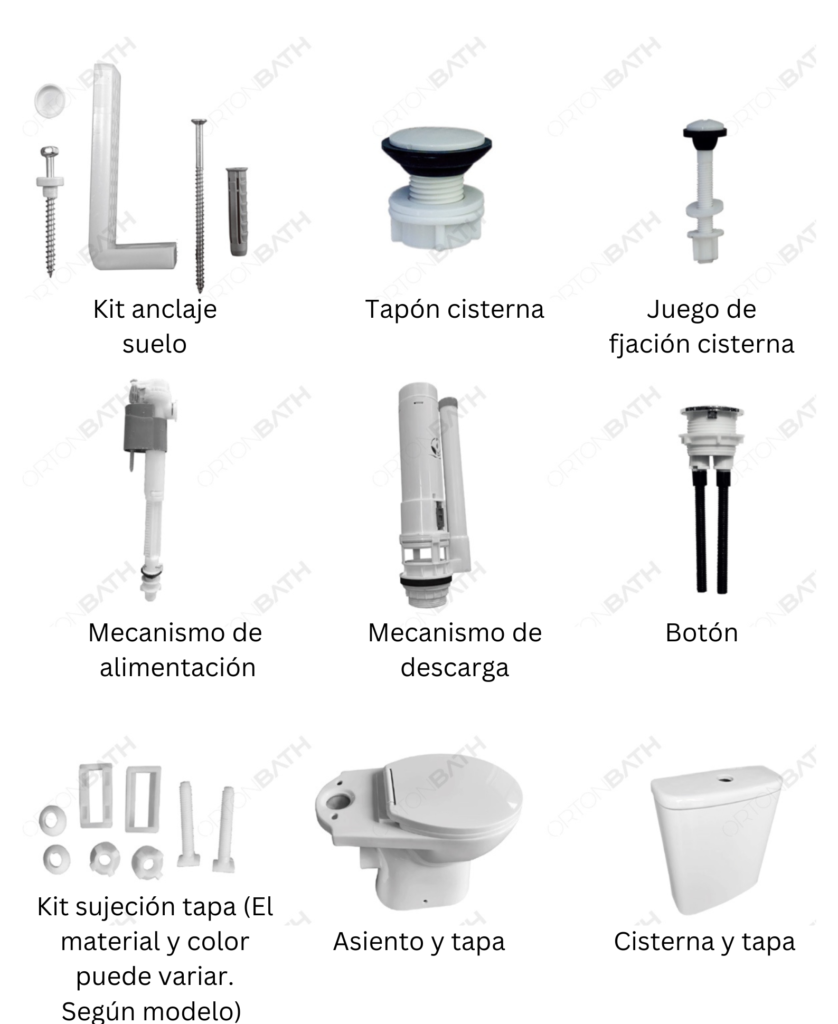
1. Turn Off Water Supply
- Close toilet supply valve and flush tank completely, use towel to remove excess
- Disconnect and remove supply line, if you are replacing the valve shut main water supply
2. Identify Outlet Installation Type
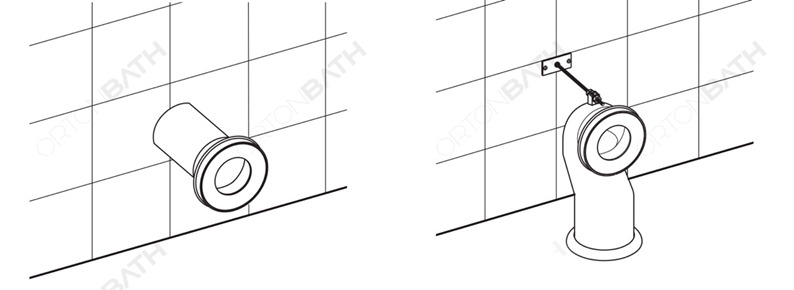
- For wall-outlet installation, place the pipe fittings as shown above.
- For floor-outlet installation, place the pipe fittings as shown above.
3. Connect Supply Hose
Thread the supply hose onto the tank.
Two optional filling
- Side filling valve installation
Optional
- Bottom inlet valve

4. connecting the cistern body to the bowl
- Position the gasket on the bowl
- Holes should line up so threaded rod can fit smoothly connecting the cistern body to the
- Slide metal washer and rubber washer onto the
- Thread bolts into the bottom of the tank then tighten the screw
- Do not overtighten, this may crack the
5. Connect Push Button
- Unscrew the big white nut on the push button and insert the button into the hole on the
- When the rods meet the push buttons, measure the height (H) with a
- Unscrew the rods and cut the part H on both rods.
- Insert the rods back and tighten the small
- Tighten the big nut from the inside of the

6. Position Toilet
- Position toilet into place and make
- Use a pencil to mark the location of the holes inside the tank onto the
- Draw one line around the base of the toilet and one perpendicular from the holes located on both sides of the
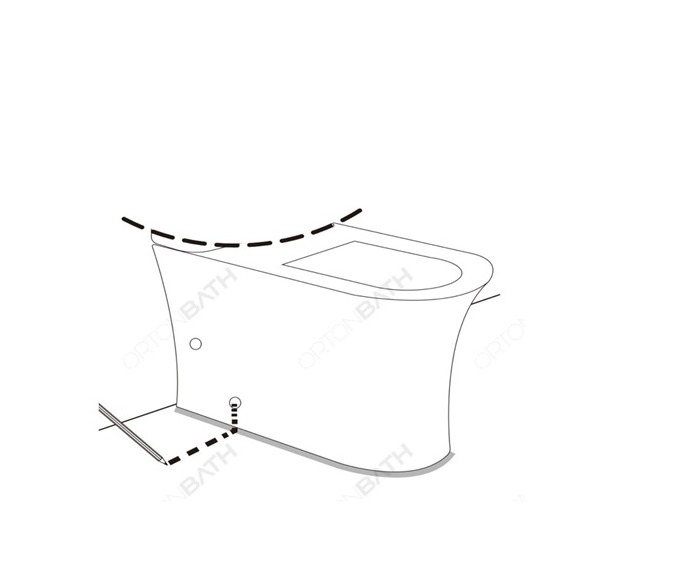
7. Drill Holes
- Remove the toilet and measure bowl
- Apply that measurement from edge to center of marks you made on the floor as shown, then
- Drill holes into locations on wall marked from

8. Install Hardware
- Install anchors into all pre-drilled
- Install brackets onto

9. Mount Your Wax Ring For A Water-Tight Seal
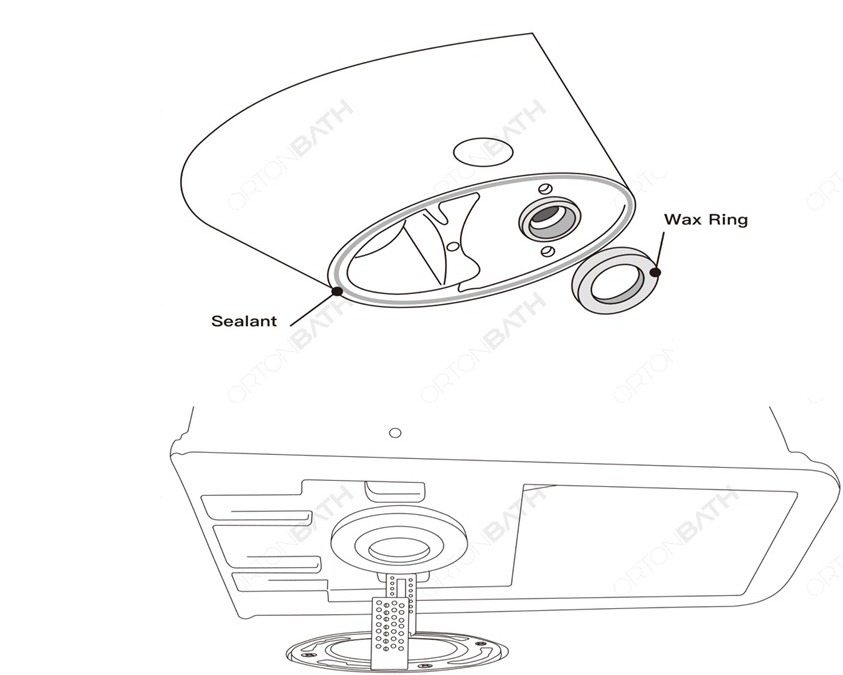
10. Secure Toilet
- Return toilet to desired
- Carefully thread bolts onto nuts on the
- Tighten to secure into place, do not over

11. Gently Place Your Skirted Toilet Over The Floor Flange Seal with silicone
12. Connect Plumbing
Connect Water Supply
13. Check for Leaks
· Flush several times and check for leaks
TOILET SEAT INSTALLATION
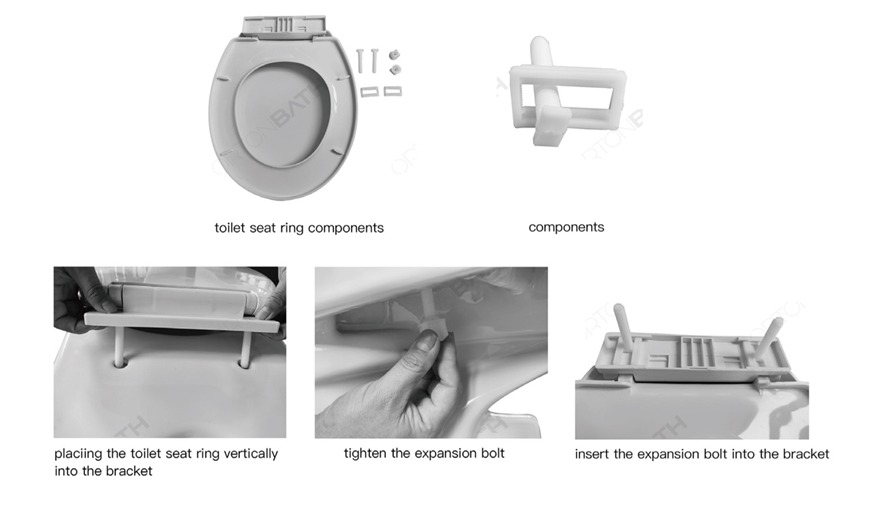
ORTONBATH® products are made with quality materials and excellent craftsmanship to provide our customers with beautiful, durable, long-lasting products. Should there be any defects in materials or craftsmanship under regular use that are discovered within the first year of installation, ORTONBATH® will provide replacement parts at no charge, or at its discretion, replace any product or part of the product that is deemed defective, under normal installation, use, service or maintenance. This warranty applies only to the original purchaser. Proof of purchase will be required in the instance of a claim.
ORTONBATH® recommends all installations of ORTONBATH® products to be conducted by a licensed, professional plumber or contractor. ORTONBATH® will not be held responsible for any damage or product failure due to improper installation, misuse, or failure to utilize a licensed professional for installation. ORTONBATH® is not responsible for any installation or removal costs.
This One Year Limited Warranty Will Be Voided If:
- The installation recommendations were not followed by the
- The product has been moved from its initial place of installation
- The product has in any way been modified from its packaged state
- The product has been subjected to improper maintenance, abuse, misuse, excessive use of chemicals, accidents, or other damages,
ORTONBATH® makes no implication that its products comply with any local building or plumbing codes. It is the consumer’s responsibility and obligation to determine local code compliance prior to and during installation. This warranty extends only to the original purchaser and first consumer.
ORTONBATH® is not responsible for any special, incidental or consequential damages associated with the installation, replacement, return or use of the original purchaser’s product. This includes, but is not limited to: freight costs, labor, travel time, lost profit, home damages and other contingent liabilities and costs (including, without limitation, costs associated with ‘professionals’ or ‘experts’, investigations, audits, analyses, attorneys and any other professional/ hired services).
The ORTONBATH® warranty is a comprehensive and explicit limit of liability. All items not disclosed within the warranty are not addressable within the responsibility of ORTONBATH® . Certain states have variances regarding implied warranties; in those situations, we remain fully compliant.
WARNING: Contents of your order may contain sharp and possibly other harmful pieces and may cause hazard to children and adults. ORTONBATH® is not responsible in any way for personal dam- ages.
Must Visit:https://ortonbaths.com/siphonic-vs-washdown-toilet-better/
Must Visit:https://ortonbaths.com/difference-between-uf-vs-pp-toilet-seat-cover/

